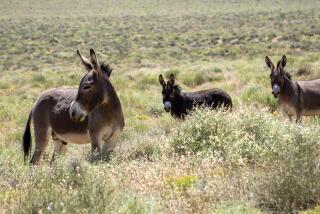Texas’ Mammoth Graveyard Is an Archeological Treasure
- Share via
WACO, Texas — Curling, fossilized tusks protrude from a stretch of cracked central Texas dirt, an archeological treasure that has local leaders pondering the value of ancient bones.
The city of Waco and Baylor University want to preserve the resting ground of a herd of prehistoric mammoths believed to have died in a mudslide some 28,000 years ago.
“There’s a pretty significant community interest to use that site for more than it is being used [for] now, which is research,” said Larry Groth, Waco’s city manager. “But there are reservations on how much it costs.”
Since a large bone was discovered 25 years ago in a dry creek bed, the remains of 24 Columbian mammoths -- warm-weather cousins of woolly mammoths -- have been found in the thick woods along the Brazos and Bosque rivers.
Researchers say the site marks the world’s largest known concentration of prehistoric mammoths dying in the same natural event.
Local officials have teamed up to discuss possibilities for the site, including building an educational center and petitioning for national park status. Building a visitors center and enclosing the area where the bones remain could cost $5.5 million, according to a study completed in November. A projected 40,000 people would visit the first year, with about 30,000 visiting in subsequent years, the study found.
The site has never been open to the public, except for the occasional school group. The city owns the five acres where the remains were found; Baylor bought the surrounding 100 acres after the discovery.
“It’s a very fine line between wanting to tell people about it and show it off versus preservation and security issues,” said Anita Benedict, exhibits coordinator for Baylor’s Mayborn Museum. The museum, set to open in May, will incorporate the school’s current science and natural history museum.
Nearby residents found the first bone in 1978 while walking through the woods, and they went to Baylor for answers. David Lintz, who retired in 2001 after working 20 years at the university’s museum, immediately knew that the bone belonged to a mammoth -- which lived in the Ice Age, was 10-12 feet tall at the shoulder and weighed 6-8 tons.
Lintz scoured the creek bed, and found teeth and bone fragments. He initiated an archeological dig and, over the next several years, museum employees, students and volunteers dug by hand to reveal more remains.
The discovery was publicized with fanfare, and a national symposium was held in Waco to discuss not only the number of creatures found and their condition, but how they died, Lintz said.
The remains indicated that the mammoths were malnourished. Researchers believe the herd was heading toward a watering hole or trying to find food when a flash flood hit, trapping them in a ravine. One calf was in the tusks of a bull, Lintz said.
“Everything collapsed on them. Very few of them are on their side,” Lintz said. “But it’s still a mystery. We’re still trying to determine what happened.”
By 1981, the excitement died down and the digging team “ran out of steam,” Lintz said. By then, the group had found eight preserved creatures. When a new museum director arrived in 1983, he obtained grants for equipment and materials to preserve the bones. Using backhoes to lift centuries of dirt, crews over the years found hundreds more bone fragments.
A flash flood in 1984 unearthed three more skeletons, bringing the number to more than a dozen. As more mammoths were found, Baylor decided to leave the bones in the ground and make casts, which will be displayed at the museum.
If a visitors center is built atop the site, designs call for a glass floor in one display area so people can look down at the embedded skeletons, Benedict said.
Although the feasibility study showed that revenue generated from visitors probably would not cover operating costs -- resulting in a $185,000 to $200,000 shortfall annually -- the project probably would move forward, Groth said. The city will pursue grants and donations to fund the project, he said.
Baylor museum employees and students no longer work at the site. They suspect that at least one more mammoth lies beneath the dirt, but they don’t want to disturb it until they know what the future holds.
“If there’s anything else out there, it’s safer to keep it buried,” Benedict said.
More to Read
Sign up for Essential California
The most important California stories and recommendations in your inbox every morning.
You may occasionally receive promotional content from the Los Angeles Times.










